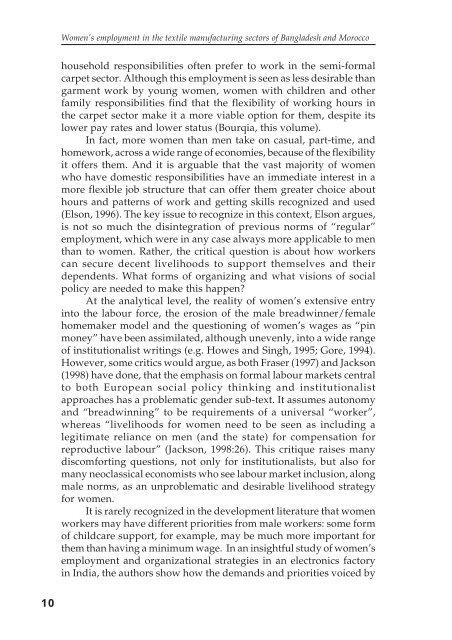Women's Employment - United Nations Research Institute for Social ...
Women's Employment - United Nations Research Institute for Social ...
Women's Employment - United Nations Research Institute for Social ...
You also want an ePaper? Increase the reach of your titles
YUMPU automatically turns print PDFs into web optimized ePapers that Google loves.
Women’s employment in the textile manufacturing sectors of Bangladesh and Morocco<br />
household responsibilities often prefer to work in the semi-<strong>for</strong>mal<br />
carpet sector. Although this employment is seen as less desirable than<br />
garment work by young women, women with children and other<br />
family responsibilities find that the flexibility of working hours in<br />
the carpet sector make it a more viable option <strong>for</strong> them, despite its<br />
lower pay rates and lower status (Bourqia, this volume).<br />
In fact, more women than men take on casual, part-time, and<br />
homework, across a wide range of economies, because of the flexibility<br />
it offers them. And it is arguable that the vast majority of women<br />
who have domestic responsibilities have an immediate interest in a<br />
more flexible job structure that can offer them greater choice about<br />
hours and patterns of work and getting skills recognized and used<br />
(Elson, 1996). The key issue to recognize in this context, Elson argues,<br />
is not so much the disintegration of previous norms of “regular”<br />
employment, which were in any case always more applicable to men<br />
than to women. Rather, the critical question is about how workers<br />
can secure decent livelihoods to support themselves and their<br />
dependents. What <strong>for</strong>ms of organizing and what visions of social<br />
policy are needed to make this happen?<br />
At the analytical level, the reality of women’s extensive entry<br />
into the labour <strong>for</strong>ce, the erosion of the male breadwinner/female<br />
homemaker model and the questioning of women’s wages as “pin<br />
money” have been assimilated, although unevenly, into a wide range<br />
of institutionalist writings (e.g. Howes and Singh, 1995; Gore, 1994).<br />
However, some critics would argue, as both Fraser (1997) and Jackson<br />
(1998) have done, that the emphasis on <strong>for</strong>mal labour markets central<br />
to both European social policy thinking and institutionalist<br />
approaches has a problematic gender sub-text. It assumes autonomy<br />
and “breadwinning” to be requirements of a universal “worker”,<br />
whereas “livelihoods <strong>for</strong> women need to be seen as including a<br />
legitimate reliance on men (and the state) <strong>for</strong> compensation <strong>for</strong><br />
reproductive labour” (Jackson, 1998:26). This critique raises many<br />
discom<strong>for</strong>ting questions, not only <strong>for</strong> institutionalists, but also <strong>for</strong><br />
many neoclassical economists who see labour market inclusion, along<br />
male norms, as an unproblematic and desirable livelihood strategy<br />
<strong>for</strong> women.<br />
It is rarely recognized in the development literature that women<br />
workers may have different priorities from male workers: some <strong>for</strong>m<br />
of childcare support, <strong>for</strong> example, may be much more important <strong>for</strong><br />
them than having a minimum wage. In an insightful study of women’s<br />
employment and organizational strategies in an electronics factory<br />
in India, the authors show how the demands and priorities voiced by<br />
10
















